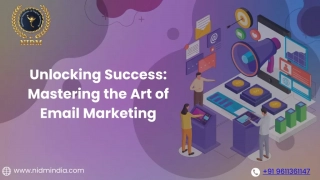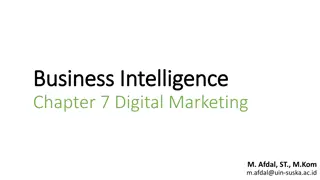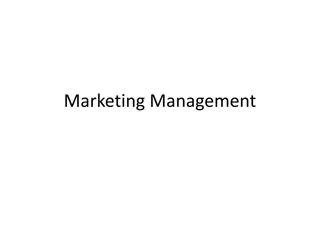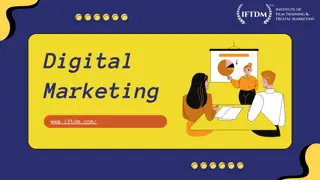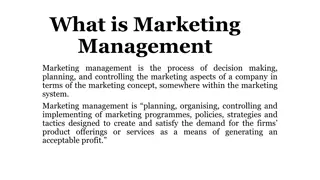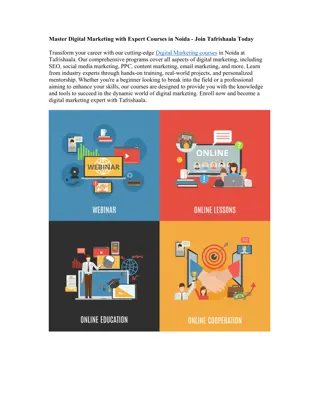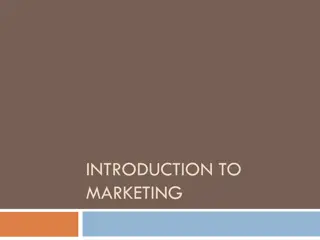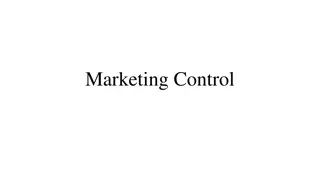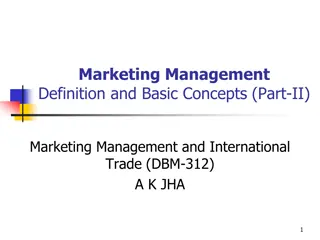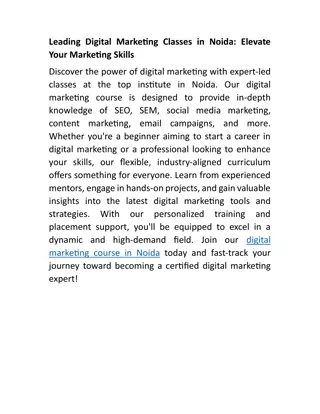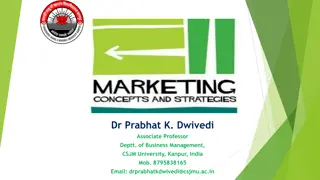Marketing: Definition, Concepts, and More
Marketing is the process of identifying and satisfying customer needs profitably through exchanges of goods, services, ideas, and experiences. It involves planning, pricing, promoting, and distributing offerings to meet individual and organizational objectives. Various definitions, concepts, and target markets are explored, emphasizing the importance of knowing customers, fulfilling their needs, and creating value through effective marketing strategies.
Download Presentation

Please find below an Image/Link to download the presentation.
The content on the website is provided AS IS for your information and personal use only. It may not be sold, licensed, or shared on other websites without obtaining consent from the author.If you encounter any issues during the download, it is possible that the publisher has removed the file from their server.
You are allowed to download the files provided on this website for personal or commercial use, subject to the condition that they are used lawfully. All files are the property of their respective owners.
The content on the website is provided AS IS for your information and personal use only. It may not be sold, licensed, or shared on other websites without obtaining consent from the author.
E N D
Presentation Transcript
What is Marketing? Marketing is about understanding: who your customers are what they need what they value Identifying your customers needs and working out how your business can fulfil those needs Marketing is the management process responsible for identifying, anticipating and satisfying customer requirements profitably.
DEFINITION Marketing is the process of planning and executing the conception, pricing, promotion and distribution of ideas, goods and services to create exchanges that satisfy individual and organizational objectives." Marketing is about knowing who your customers are, understanding what they need and telling them how you can fulfil those needs in a way that encourages them to buy from your business.
More definitions Satisfying needs and wants through an exchange process A social and managerial process by which individuals and groups obtain what they want and need through creating, offering and exchanging products of value with others Philip Kotler The management process responsible for identifying, anticipating and satisfying customer requirements profitably". Chartered Institute of Marketing
What can be marketed? Goods Services Experiences Events Persons Places Organisations Ideas
Market Market Physical place for buyers and sellers Product/ service class Need market Demographic Geographic Job
Marketplace Marketspace Meta market
Target markets Segmentation Marketer Prospect
Needs Wants Demands
Need basic requirements Want- Need directed to specific objects Demand Want backed by the ability to pay and the willingness to buy
Type of Need Definition Stated What the customer asks for Real What the stated needs actually mean Unstated What the customer also expects but does not ask for Delight Secret Needs that are not essential but would delight if met Needs that the customer does not express, often intangible in nature
Types of needs Stated needs The need as stated by the customer. E.g. I want a Mercedes Real needs The customer wants something that is exclusive, not easily available. Unstated needs The customer expects the dealer to give him preferred treatment Delight needs The customer wants the dealer to give him a registration number of his choice Secret needs The customer wants others to appreciate his exclusive possession and speak about it.
Value proposition Product Offering Brand
Value = Benefits = 2 3 2 6 5 Costs 2 2 1 4 2 Benefits = Functional benefit+ Emotional benefit Costs = Time + Money +Energy+ Psychological cost Value is 1 Customer satisfaction Value > 1 Customer delight Value < 1-Customer dissatisfaction Value = QSP (customer value triad) = Quality, Service, Price How to increase value? Increase benefits Decrease the cost Increase benefits more than increase in cost Decrease cost more than decrease in benefits Increase the benefits and reduce the cost
Exchange 2 parties minimum Both of them should have something of value to the other party Both the parties should be able to communicate and deliver Both the parties have the right to refuse Both the parties should believe that the other party is worthy of a transaction. Transaction Exchange of equal values is a transaction Transfer
Features of marketing 1. Systematic Process 2. Ideas, Goods and Services 3. Target Markets 4. All Pervasive 5. Customer Satisfaction 6. Competitive Advantage 7. Corporate Image 8. Expansion of Business 9. Organizational Objectives 10. Marketing Environment 11. Integrated Approach 12. Societal Interest
Features of marketing Regular and continuous economic activity Facilitates satisfaction of human wants Relates to goods and services Brings transfer of ownership Creates utility Core aspect of business Evolutionary Art as well as science
Advantages of marketing Satisfies customer wants Increases sales and profits Increases goodwill Competitive advantage Builds corporate image Customer satisfaction Educates customers Customer relationship Expansion of business Economies of scale Improves standard of living
Advantages of marketing Protects customers Provides channels of communication Helps in introducing new products Leads to economic development Generates employment Optimum utilisation of resources Helps in achieving organisational objective Builds brand equity Build brand loyalty Builds brand image
Social relationship/ Relationship marketing Process of creating, maintaining and enhancing strong long term trusting relationships with customers, distributors, dealers and suppliers Relationships can be improved through (Customers) Handling objections effectively Reliable after sales service Regular communication Consumer education Sales promotion
Relationships can be improved through (Dealers/ Suppliers) Attractive payment options Healthy competition Participation Communication Incentives
Steps in Relationship marketing Identify important customers Assign relationship managers Prepare detailed job descriptions Develop CRM plans and programs Remain in touch with customers Coordinate and review performance of RMs
Holistic marketing Relationship marketing Integrated marketing Internal marketing Performance marketing / Societal marketing
Scope of marketing (functional areas) Marketing research Product planning and development Advertising Sales promotion Pricing Physical distribution Personal selling After- sales service
Scope of marketing (functional areas) Test marketing Marketing information systems (MIS) Customer Relationship Management (CRM) Branding Packaging Marking / labelling Positioning Public relations Direct marketing Digital marketing
Scope of marketing (areas of application) Goods Services Experiences Events Persons Places Properties Organisations Information Ideas
Marketing Mix 4Ps of marketing James Culliton coined the term Marketing Mix He called the marketing manager as a Mixer of Ingredients Marketing Mix is a set of marketing tools that the firm uses to pursue its marketing objectives in the target market. Marketing mix is a blend of tools used by a firm to persuade its customers to buy its products Jerome McCarthy classified these tools into 4 broad categories, known as the 4 Ps of marketing Product Price Place Promotion
4Cs of marketing from Customers perspective Robert Lauterborn proposed the 4 Cs Customer Value (Needs and Wants) / benefits/ solution Cost Convenience Communication
Features Continuous Process Planning and executing 4 Ps (Product, Price, Promotion, Place) Ideas , goods and services Creates exchanges Customer satisfaction Ownership Achievement of organisational objectives Increase in sales Increase in market share
Market share Shampoo industry = 100000 units 4 brands = 100% shampoo market Sunsilk = 40000 Dove = 35000 WOW = 15000 Tressemme = 10000 Market share of WOW=
Advantages of marketing (To the company) Increase their goodwill (Brand equity) Competitive advantage Increase in sales Increase in profits Economies of scale Brand recognition (Brand image) Widens market Corporate reputation (Corporate Image) Sustains business Market knowledge Optimum utilisation of resources Bringing new product Brand loyalty Promotion of Word of Mouth publicity Helps in preventing negative publicity/ rumours Employee loyalty
Advantages of marketing (To the society) Boost Economic growth Employment opportunities Spreads awareness about products and services Improves standard of living Helps in protecting local culture Improved products through better market research
Advantages of marketing (To the intermediaries) Boosts sales and profits Reduces cost of advertising Market feedback and information Reduces selling costs Reduces sales promotion costs Credit facilities Support Promotions Storage facilities
Advantages of marketing (To the customer) Wide variety Market knowledge Customer satisfaction Improves standard of living Provides Utility Improved customer service Customer education Customer protection Keep up with latest trends Lowers costs Better quality products
Brand Brand Brand Identity Brand Image Corporate reputation Brand equity




